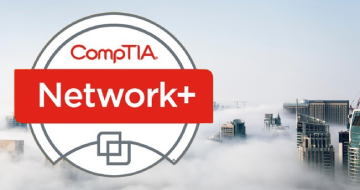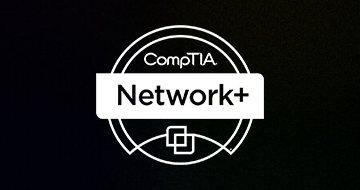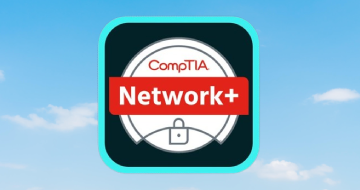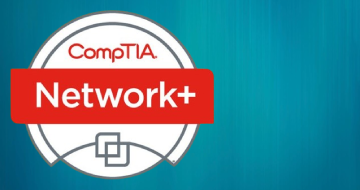IIRF Online > IT & Software > Network & Security > CompTIA Network+ > Complete CompTIA Network+ (N10-008) Video Training Series
Complete CompTIA Network+ (N10-008) Video Training Series by Udemy
Get ready to CRUSH your CompTIA Network+ exam, as you’re guided through every topic on the N10-008 exam blueprint.
Course Highlights
- Gain the prerequisite knowledge to pass the CompTIA Network+ Exam (N10-008)
- The skills you learn as part of the CompTIA Network+ Certification can help you land a job
- Learn how to subnet a network
- Learn how networks actually work
- Learn how to configure and manage network devices
- Learn how to implement network security, standards and protocols
- Learn how to support the creation of virtualized networks
- Understand the differences between routers and switches and learn how to segment network traffic to create resilient networks
- Learn network troubleshooting skills and the tools to use to troubleshoot networks
Skills you will learn!
Curriculum
1 Topic
0.0 Welcome to the Course!
8 Topics
1.0 Introducing Reference Models and Protocols
1.1 OSI Model
1.2 TCP:IP Model
1.3 IP ICMP UDP and TCP
1.4 IP UDP and TCP Headers.mov
1.5 Maximum Transmission Unit (MTU)
1.6 Ports and Protocols
Module 1 Quiz
13 Topics
2.0 Network Pieces and Parts
2.1 Analog Modems
2.2 CSMA-CD vs CSMA-CA
2.3 Hubs Switches and Routers
2.4 Collision and Broadcast Domains
2.5 Wireless Access Points
2.6 Firewalls
2.7 Intrusion Detection and Prevention
2.8 VPN Concentrators
2.9 Load Balancers
2.10 Advanced Filtering Appliances
2.11 Proxy Server
Module 2 Quiz
19 Topics
3.0 Describing Network Topologies
3.1 Star Topology
3.2 Mesh Topology
3.3 Ring Topology
3.4 Bus Topology
3.5 Point-to-Point Topology
3.6 Point-to-Multipoint Topology
3.7 Hybrid Topology
3.8 Client-Server Network
3.9 Peer-to-Peer Network
3.10 Local Area Network (LAN)
3.11 Wide Area Network (WAN)
3.12 Metropolitan Area Network (MAN)
3.13 Campus Area Network (CAN)
3.14 Personal Area Network (PAN)
3.15 Wireless LAN (WLAN)
3.16 Software-Defined WAN (SD-WAN)
3.17 Industrial Control Systems and SCADA
Module 3 Quiz
13 Topics
4.0 Understanding Network Services
4.1 Virtual Private Networks (VPNs)
4.2 Dynamic Multipoint VPNs (DMVPNs)
4.3 Web Services
4.4 Voice Services
4.5 DHCP
4.6 DNS
4.7 NAT
4.8 NTP
4.9 SDN
4.10 IoT
4.11 SIP Trunks
Module 4 Quiz
15 Topics
5.0 Selecting WAN Technologies
5.1 Packet Switched vs. Circuit Switched Networks
5.2 Cellular
5.3 Frame Relay
5.4 ATM
5.5 Satellite
5.6 Cable
5.7 PPP
5.8 PPPoE
5.9 DSL
5.10 Leased Lines
5.11 ISDN
5.12 MPLS
5.13 Metro Ethernet
Module 5 Quiz
14 Topics
6.0 Connecting Networks with Cables and Connectors
6.1 Copper Cables
6.2 Fiber Cables
6.3 Copper Connectors
6.4 Fiber Connectors
6.5 Media Converters
6.6 Transceivers
6.7 Termination Points
6.8 Cabling Tools
6.9 Punch-Down Blocks
6.10 T568 Standards
6.11 Straight-Through vs. Crossover Cables
6.12 Ethernet Standards
Module 6 Quiz
17 Topics
7.0 Using Ethernet Switches
7.1 MAC Addresses
7.2 Ethernet Switch Frame Forwarding
7.3 VLAN Theory
7.4 Trunking Theory
7.5 Voice VLANs
7.6 Ethernet Port Flow Control
7.7 Power over Ethernet (PoE)
7.8 Introducing Spanning Tree Protocol (STP)
7.9 STP Port States
7.10 STP Example
7.11 STP Convergence Times
7.12 STP Variants
7.13 Link Aggregation
7.14 Port Mirroring
7.15 Distributed Switching
Module 7 Quiz
8 Topics
8.0 Demystifying Wireless Networks
8.1 Introduction to Wireless LANs (WLANs)
8.2 WLAN Antennas
8.3 Wireless Range Extenders
8.4 WLAN Frequencies and Channels
8.5 WLAN Standards
8.6 Regulatory Impacts of Wireless Channels
Module 8 Quiz
15 Topics
9.0 Addressing Networks with IPv4
9.1 Binary Numbering
9.2 Binary Practice Exercise #1
9.3 Binary Practice Exercise #2
9.4 IPv4 Address Format
9.5 Public vs. Private IPv4 Addresses
9.6 IPv4 Unicast Broadcast and Multicast
9.7 The Need for Subnetting
9.8 Calculating Available Subnets
9.9 Calculating Available Hosts
9.10 Subnetting Practice Exercise #1
9.11 Subnetting Practice Exercise #2
9.12 Calculating Usable Ranges of IPv4 Addresses
9.13 Subnetting Practice Exercise #3
Module 9 Quiz
19 Topics
10.0 Addressing Networks with IPv6
10.1 Hexadecimal Numbering
10.2 IPv6 Address Format
10.3 Shortening an IPv6 Address
10.4 IPv6 Address Shortening Exercise
10.5 IPv6 Global Unicast
10.6 IPv6 Multicast
10.7 IPv6 Link Local
10.8 IPv6 Unique Local
10.9 IPv6 Loopback
10.10 IPv6 Unspecified
10.11 IPv6 Solicited-Node Multicast
10.12 EUI-64 Address
10.13 IPv6 Autoconfiguration
10.14 IPv6 Traffic Flows
10.15 Dual Stack
10.16 Tunneling IPv6 Through an IPv4 Network
10.17 IP Address Management (IPAM)
Module 10 Quiz
10 Topics
11.0 Explaining IP Routing
11.1 Packet flow in a Routed Network
11.2 Static and Default Routes
11.3 Routing Protocols
11.4 RIP
11.5 OSPF
11.6 EIGRP
11.7 BGP
11.8 Subinterfaces
Module 11 Quiz
8 Topics
12.0 Streaming Voice and Video with united communications
12.1 Voice over IP
12.2 Video over IP
12.3 Unified Communications Networks
12.4 Quality of Service (QoS) Fundamentals
12.5 QoS Markings
12.6 QoS Traffic Shaping and Policing
Module 12 Quiz
10 Topics
13.0 Virtualizing Network Devices
13.1 Virtualized Devices
13.2 Virtual IP
13.3 Storage Area Network (SAN) Technologies
13.4 Using InfiniBand for SANs
13.5 Cloud Technologies
13.6 Accessing Cloud Services
13.7 Infrastructure as Code
13.8 Multi-Tenancy
Module 13 Quiz
24 Topics
14.0 Securing a Network
14.1 General Security and Availability Issues
14.2 Vulnerabilities and Exploits
14.3 Denial of Service Attacks
14.4 On-Path Attacks
14.5 VLAN Hopping Attacks
14.6 Social Engineering Attacks
14.7 Other Common Attacks
14.8 Common Defense Strategies
14.9 Switch Port Defense
14.10 Access Control Lists
14.11 Wireless Security Options
14.12 Extensible Authentication Protocols (EAPs)
14.13 Authentication Servers
14.14 User Authentication
14.15 Physical Security
14.16 Forensic Concepts
14.17 Securing STP
14.18 Router Advertisement (RA) Guard
14.19 Securing DHCP
14.20 IoT Security Concerns
14.21 Cloud Security
14.22 IT Risk Management
Module 14 Quiz
7 Topics
15.0 Monitoring and Analyzing Networks
15.1 Device Monitoring Tools
15.2 SNMP
15.3 Remote Access Methods
15.4 Environment Monitoring
15.5 Wireless Network Monitoring
Module 15 Quiz
14 Topics
16.0 Examining Best Practices for Network Administration
16.1 Safety Procedures
16.2 Wiring Management
16.3 Power Management
16.4 Rack Management
16.5 Change Control
16.6 High Availability
16.7 Cloud High Availability
16.8 Active-Active vs. Active-Passive
16.9 Disaster Recovery
16.10 Standards Policies and Rules
16.11 Documentation
16.12 Site Survey
Module 16 Quiz
11 Topics
17.0 Troubleshooting Networks
17.1 7-Step Troubleshooting Methodology
17.2 CLI Troubleshooting Utilities
17.3 Network Appliance Commands
17.4 Device Metrics and Sensors
17.5 Environmental Metrics and Sensors
17.6 Common LAN Issues
17.7 Common Wireless Network Issues
17.8 Common Network Service Issues
17.9 General Networking Issues
Module 17 Quiz
4 Topics
18.0 Preparing for the CompTIA Network+ Exam
18.1 How to Register for the Exam
18.2 Study Strategies
18.3 What to do on Exam Day
1 Topic
19.0 Wrap-Up
2 Topics
Network+ (N10-008) Practice Exam #1
Network+ (N10-008) Practice Exam #2
1 Topic
Where to Get Help with Your Studies

Complete CompTIA Network+ (N10-008) Video Training Series




